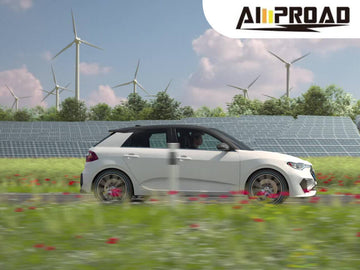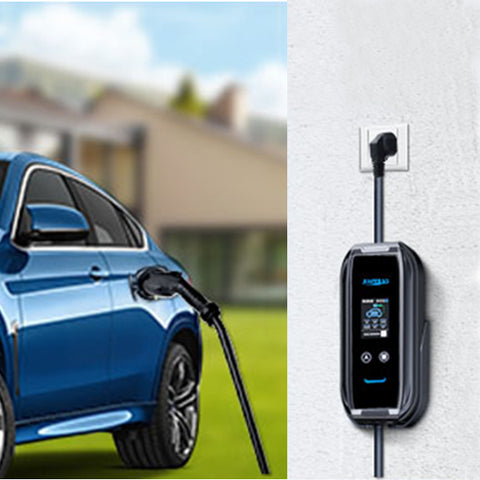
Electric vehicles (EVs) are zooming onto the scene, and with great power comes...well, the responsibility to charge safely! Improper EV charging setups can lead to a zap you don't want - electrical shocks - or even a fiery situation. But fear not, fellow EV enthusiast! This exploration will show you how to keep your charging sessions safe and sound, so you can focus on the road ahead. We'll cover everything from the right equipment to everyday practices to ensure your EV gets the juice it needs, worry-free.
Why is it Essential to Rely on Qualified Professionals?
Ensuring the safety of your electric vehicle (EV) charging setup is paramount, and relying on qualified professionals can make all the difference. Here's why:
Electrician Installation for Level 2 EV Chargers
When installing a Level 2 charger at your home or workplace, it's crucial to enlist the services of a qualified electrician. These professionals have the expertise to assess your electrical system's capacity, properly wire the charging station, and ensure compliance with local building codes and safety standards. By entrusting the installation to an electrician, you can minimize the risk of electrical hazards, such as overloaded circuits or faulty wiring, and ensure safe and efficient charging for your EV.
Following Manufacturer Instructions
Whether you're installing a Level 2 EV charger or using a portable EV charger, it's essential to follow the manufacturer's instructions meticulously. These instructions provide valuable guidance on proper installation, operation, and maintenance of the charging equipment, as well as specific recommendations for compatibility with your EV model. By adhering to the manufacturer's guidelines, you can avoid potential risks such as electrical malfunctions, damage to the charging station or vehicle, and personal injury.
Ultimately, prioritizing safety when installing and using EV chargers is essential for protecting both your property and your well-being. By engaging qualified professionals for Level 2 EV charger installation and diligently following manufacturer instructions for all charging equipment, you can mitigate potential risks and enjoy peace of mind knowing that your EV charging setup is safe, reliable, and compliant with industry standards.
What Key Features Should I Look for in an EV Charging Station?
When selecting an EV charging station, prioritizing safety features is paramount to ensure the protection of both your vehicle and your property. Here are key safety features to look for:
- Ground Fault Circuit Interrupter (GFCI) or Residual Current Device (RCD) Protection:
A ground fault circuit interrupter (GFCI) or residual current device (RCD) is a critical safety feature that detects imbalances in the electrical current and quickly shuts off power to prevent electrical shocks. This protection mechanism is essential for EV charging stations, especially those installed in outdoor or damp environments where the risk of electrical hazards is higher.
- Overcurrent Protection:
Overcurrent protection is another vital safety feature designed to safeguard against overheating and potential fire hazards. This feature monitors the flow of electrical current and automatically disconnects power if it exceeds safe levels, preventing damage to the charging station, vehicle, and surrounding infrastructure. Overcurrent protection is essential for preventing electrical accidents and ensuring the safe operation of the EV charging station.
- Temperature Monitoring:
Temperature monitoring capabilities are crucial for detecting and responding to excessive heat buildup during the charging process. EV charging stations equipped with temperature sensors can monitor the temperature of the charging components and automatically shut down charging if temperatures exceed safe limits. This proactive measure helps prevent overheating-related issues such as fires or damage to the charging station and EV battery, enhancing overall safety and reliability.
AMPROAD Reliable Portable Level 2 EV Charger
The AMPROAD reliable portable Level 2 EV charger incorporates these essential safety features to provide users with peace of mind during charging sessions. With built-in GFCI or RCD protection, overcurrent protection, and temperature monitoring capabilities, the AMPROAD charger ensures safe and reliable charging for electric vehicles. Whether at home or on the go, EV owners can trust the AMPROAD charger to deliver efficient charging while prioritizing safety at all times.
By prioritizing EV charging stations equipped with these essential safety features, you can minimize risks and confidently charge your electric vehicle knowing that safety is a top priority.
Creating a Safe Charging Environment
Charging your electric vehicle (EV) at home is convenient and efficient, but it's essential to prioritize safety. Here are some best practices to ensure a safe charging environment:
Use a Dedicated Outlet or Circuit for Home EV Chargers
For Level 2 home EV charger, it's advisable to use a dedicated outlet or have a dedicated circuit installed. This ensures that the charger receives a consistent power supply without overloading existing circuits. A dedicated outlet or circuit reduces the risk of electrical hazards, such as overheating or circuit tripping, and promotes safe and efficient charging for your EV.
Visually Inspect the Charging Cable Before Each Use
Before plugging in your EV to charge, take a moment to visually inspect the charging cable for any signs of damage or wear. Look for frayed wires, exposed conductors, or any other abnormalities that could compromise the integrity of the cable. If you notice any damage, refrain from using the cable and seek a replacement or repair to prevent potential safety hazards during charging.
Avoid Extreme Temperatures During Charging
Extreme temperatures, whether hot or cold, can impact the performance and safety of your home EV charger. Avoid placing the charger in direct sunlight or exposing it to extreme cold temperatures, as this can affect its functionality and longevity. Instead, choose a shaded area or a location protected from the elements to ensure optimal charging conditions and minimize the risk of damage or malfunction.
Keep the Charging Area Free from Hazards
Maintain a clear and clutter-free charging area to minimize potential safety hazards. Keep the charging station and surrounding area free from flammable materials, liquids, and debris that could pose a fire risk or interfere with charging operations. Additionally, ensure that the charging area is dry and free from moisture to prevent electrical shocks or corrosion of charging equipment.
By following these best practices for safe charging at home, you can enjoy the convenience of charging your EV while prioritizing safety for yourself, your property, and your vehicle. Regularly inspecting equipment, using dedicated outlets or circuits, and maintaining a clean and hazard-free charging environment are essential steps to ensure a safe and efficient charging experience.
Maintaining Your EV Charging Setup
To ensure the continued safety and performance of your electric vehicle (EV) charging setup, regular maintenance is key. Here are essential steps to maintain your EV charging equipment:
Schedule Periodic Inspections by a Qualified Electrician
Regular inspections by a qualified electrician are essential to identify and address any potential issues with your EV charging setup. These professionals can assess the condition of your charging station, wiring, and electrical components, ensuring they meet safety standards and function optimally. Schedule periodic inspections, especially after installation or significant changes to your electrical system, to catch any potential problems early and prevent safety hazards or performance issues.
Clean the Charging Connectors Regularly
Keeping the charging connectors clean is crucial for maintaining reliable connections and efficient charging. Follow the manufacturer's recommendations for cleaning the charging connectors, which may include using a soft cloth or brush to remove dirt, debris, and corrosion. Regular cleaning helps prevent oxidation and buildup on the connectors, ensuring a secure and uninterrupted flow of electricity during charging sessions.
Additional Tip: Utilize Tesla Destination Charger for Enhanced Convenience
For Tesla owners, utilizing the Tesla Destination Charger can provide added convenience and accessibility to charging facilities. Tesla Destination Chargers are specifically designed for Tesla vehicles and are often installed at hotels, restaurants, and other public locations. By taking advantage of these chargers, Tesla owners can enjoy fast and convenient charging while on the go, further enhancing the overall EV ownership experience.
By prioritizing regular maintenance and utilizing resources such as Tesla Destination Chargers, EV owners can ensure the continued safety, reliability, and performance of their charging setup. Whether scheduling inspections with a qualified electrician or cleaning charging connectors according to manufacturer recommendations, proactive maintenance efforts are essential for optimal EV charging experiences.
How Can User Awareness Ensure Peace of Mind?

User awareness is paramount for ensuring the safety and reliability of your electric vehicle (EV) charging experience. By staying informed and vigilant, you can mitigate potential risks and enjoy peace of mind. Here's why user awareness is crucial:
Recognizing Warning Signs
Being familiar with the warning signs of potential issues is essential for early detection and prevention of problems. Keep an eye out for unusual sounds, such as buzzing or sparking, and be alert to any strange odors or signs of overheating emanating from the charging equipment. Promptly addressing these warning signs can help prevent safety hazards and ensure the continued operation of your EV charging setup.
Knowing How to Safely Disconnect the Charger
In case of an emergency or malfunction, knowing how to safely disconnect the charger is critical to avoid further damage or injury. Familiarize yourself with the emergency disconnect procedure for your specific charging equipment, including how to shut off power and safely disconnect the charging cable from your vehicle. By being prepared and informed, you can take swift action to address any issues and maintain a safe charging environment.
By prioritizing user awareness and staying informed about potential risks and safety protocols, EV owners can take proactive measures to ensure the safety and reliability of their charging setup. Whether recognizing warning signs of potential issues or knowing how to safely disconnect the charger in emergencies, user awareness plays a vital role in promoting a positive EV charging experience.
FAQs / People Also Ask
1. How often should I schedule inspections for my EV charging equipment?
It's recommended to schedule periodic inspections by a qualified electrician for your EV charging setup, especially after installation or significant changes to your electrical system. Regular inspections help identify and address potential issues early, ensuring the continued safety and performance of your charging equipment.
2. What are some common warning signs of potential issues with EV charging equipment?
Common warning signs include unusual sounds such as buzzing or sparking, strange odors, and signs of overheating emanating from the charging equipment. Recognizing these warning signs is essential for early detection and prevention of safety hazards.
3. How can I safely disconnect the charger in case of an emergency?
In case of an emergency or malfunction, it's crucial to know how to safely disconnect the charger to avoid further damage or injury. Familiarize yourself with the emergency disconnect procedure for your specific charging equipment, including how to shut off power and safely disconnect the charging cable from your vehicle.
4. Are there any specific cleaning recommendations for EV charging connectors?
Follow the manufacturer's recommendations for cleaning the charging connectors, which may include using a soft cloth or brush to remove dirt, debris, and corrosion. Regular cleaning helps maintain reliable connections and efficient charging.
5. Can I use a Tesla Destination Charger for non-Tesla electric vehicles?
Tesla Destination Chargers are specifically designed for Tesla vehicles and may not be compatible with non-Tesla electric vehicles. It's essential to check compatibility before attempting to use a Tesla Destination Charger with a non-Tesla EV.
6. What should I do if I encounter any issues with my EV charging equipment?
If you encounter any issues with your EV charging equipment, such as unusual sounds, odors, or malfunctions, discontinue use immediately and seek professional assistance. Contact a qualified electrician or the manufacturer for troubleshooting and repair services to ensure the safety and reliability of your charging setup.




